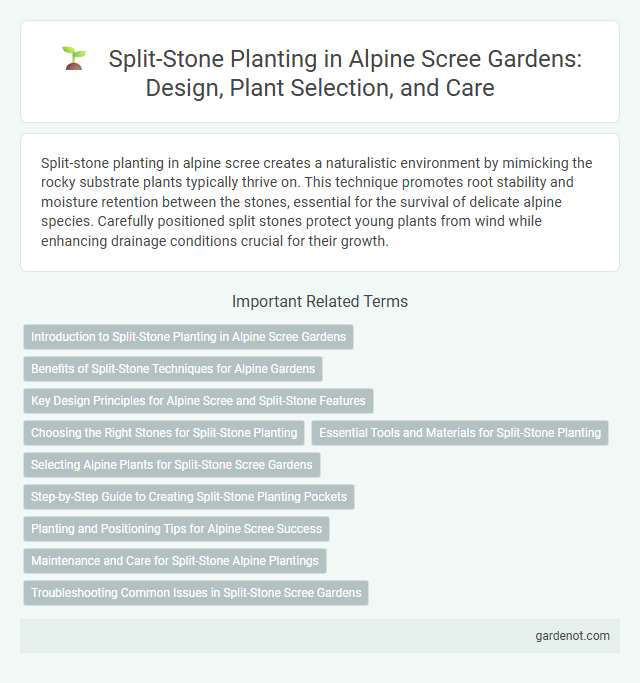Split-stone planting in alpine scree creates a naturalistic environment by mimicking the rocky substrate plants typically thrive on. This technique promotes root stability and moisture retention between the stones, essential for the survival of delicate alpine species. Carefully positioned split stones protect young plants from wind while enhancing drainage conditions crucial for their growth.
Introduction to Split-Stone Planting in Alpine Scree Gardens
Split-stone planting in alpine scree gardens involves embedding plants into cracks or crevices of split stones to mimic natural alpine habitats. This technique enhances drainage and aeration, creating micro-environments essential for drought-tolerant and cold-resistant alpine species like saxifrages, sedums, and cushion plants. Carefully arranging split stones supports root development and protects delicate plants from harsh weather by replicating native scree conditions.
Benefits of Split-Stone Techniques for Alpine Gardens
Split-stone planting enhances alpine gardens by improving drainage and preventing root rot, critical for the delicate balance of high-altitude flora. This technique creates microclimates within the scree, promoting healthy growth of specialized alpine plants like saxifrage and edelweiss. Incorporating split-stone structures also stabilizes soil, reducing erosion and supporting sustainable garden maintenance.
Key Design Principles for Alpine Scree and Split-Stone Features
Split-stone planting in alpine scree landscapes emphasizes strategic placement of hardy, drought-tolerant species between fractured rocks to mimic natural alpine conditions. Key design principles include ensuring proper drainage, using coarse, well-draining substrate, and selecting a diverse mix of low-growing, textured plants that thrive in nutrient-poor soils. Incorporating angular split-stone features creates microclimates that protect roots from temperature extremes and retain moisture, enhancing plant survival in harsh alpine environments.
Choosing the Right Stones for Split-Stone Planting
Selecting the right stones for split-stone planting involves prioritizing angular, flat stones with sharp edges that create natural crevices ideal for root anchorage and moisture retention. Stones sourced from local quarries with mineral compositions compatible to the native soil enhance plant health and stability. Properly chosen split-stones improve drainage while providing protective microclimates crucial for alpine scree vegetation to thrive.
Essential Tools and Materials for Split-Stone Planting
Essential tools for split-stone planting in alpine scree environments include a sturdy trowel, gloves, and a small hand rake to carefully position stones and soil without damaging delicate roots. Materials such as well-draining gritty soil mixes, split stones of various sizes, and drought-resistant alpine plants like sedums and saxifrages ensure stability and optimal growth conditions. Using porous split stones enhances moisture retention and aeration, critical for the survival of alpine species in scree habitats.
Selecting Alpine Plants for Split-Stone Scree Gardens
Selecting alpine plants for split-stone scree gardens requires prioritizing species with high drought tolerance and strong root systems suited for well-drained, rocky substrates. Saxifragas, sedums, and various cushion plants thrive in crevices, stabilizing stones while enhancing biodiversity. Optimal plant choice improves scree stability and mimics natural alpine environments, supporting local pollinators and ensuring garden resilience.
Step-by-Step Guide to Creating Split-Stone Planting Pockets
Creating split-stone planting pockets involves carefully selecting durable, weather-resistant stones that mimic natural alpine scree environments. Begin by splitting larger rocks into manageable pieces to form stable pockets, ensuring adequate drainage through strategically placed gaps. Fill these pockets with well-draining, gravelly soil blended with organic matter suitable for alpine plants, promoting root aeration and moisture control essential for thriving vegetation.
Planting and Positioning Tips for Alpine Scree Success
Split-stone planting in alpine scree requires careful selection of well-draining, gritty soil mixed with coarse sand and gravel to mimic natural conditions. Position plants in south-facing, sheltered spots with partial shade to protect from harsh winds while maximizing sunlight exposure. Ensure stones are firmly embedded to stabilize roots and retain moisture, promoting healthy growth in this challenging environment.
Maintenance and Care for Split-Stone Alpine Plantings
Split-stone alpine plantings require minimal maintenance due to their natural adaptation to rocky, well-drained environments, with occasional watering during prolonged dry periods to support root establishment. Removing weeds promptly helps prevent competition for nutrients and moisture, ensuring the health of alpine species like saxifrages and sedums. Fertilization is rarely necessary, but applying a slow-release, low-nitrogen fertilizer in early spring can enhance growth and flowering in nutrient-poor scree conditions.
Troubleshooting Common Issues in Split-Stone Scree Gardens
Split-stone scree gardens often face drainage problems, leading to root rot and plant decay, which can be mitigated by ensuring well-draining soil mixtures and proper slope design. Nutrient deficiency is common in rocky substrates, so incorporating slow-release fertilizers tailored for alpine plants helps maintain vigorous growth. Pest infestations, especially spider mites and aphids, require regular monitoring and organic treatments to protect delicate alpine species in these challenging environments.
Split-stone planting Infographic

 gardenot.com
gardenot.com